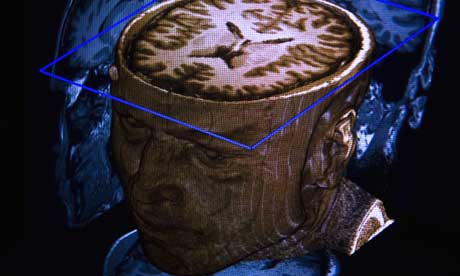
Neuroscience and marketing had a love child a few years back. Its name – big surprise – is neuromarketing, and the ugly little fellow is growing up. Corporate pitchmen have always wanted to get inside our skulls. The more accurately they can predict how we’ll react to stimuli in the marketplace, from prices to packages to adverts, the more money they can pull from our pockets and transfer to their employers’ coffers.
But picking the brains of consumers hasn’t been easy. Marketers have had to rely on indirect methods to read our thoughts and feelings. They’ve watched what we do in stores or tracked how purchases rise or fall in response to promotional campaigns or changes in pricing. And they’ve carried out endless surveys and focus groups, asking us what we buy and why.
The results have been mixed at best. People, for one thing, don’t always know what they’re thinking, and even when they do, they’re not always honest in reporting it. Traditional market research is fraught with bias and imprecision, which forces companies to fall back on hunches and rules of thumb.
But thanks to recent breakthroughs in brain science, companies can now actually see what goes on inside our minds when we shop. Teams of academic and corporate neuromarketers have begun to hook people up to functional magnetic resonance imaging (fMRI) machines to map how their neurons respond to products and pitches.
Last year, the journal Neuron published an article titled Neural Predictors of Purchases by a group of scholars from three leading US universities. The researchers described how they had used brain imaging to monitor the mental activity of shoppers as they evaluated products and prices on computer screens.
By watching how different neural circuits light up or go dark during the buying process, the researchers found they could predict whether a person would end up purchasing a product or passing it up. They concluded, after further analysis of the results, that “the ability of brain activation to predict purchasing would generalise to other purchasing scenarios”.
The American business magazine Forbes heralded the study as a milestone in business, saying it marked the first time researchers have been able “to examine what the brain does while making a purchasing decision”.
At McLean Hospital, a prestigious psychiatric institution run by Harvard University, an advertising agency recently sponsored an experiment in which the brains of half-a-dozen young whiskey drinkers were scanned. The goal, according to a report in Business Week, was “to gauge the emotional power of various images, including college kids drinking cocktails on spring break, twentysomethings with flasks around a campfire, and older guys at a swanky bar”. The results were used to fine-tune an ad campaign for the maker of Jack Daniels.
A new group of high-tech consulting firms, with names like NeuroFocus and Neuroconsult, have sprung up to help companies deploy neuromarketing. The neuromarketers are playing a prominent role at Re:think, the Advertising Research Foundation’s annual convention, held in New York this week. The New York Times reports its agenda is “filled with presentations” on the new scientific approaches to marketing.
In the future, marketers won’t have to ask us what we think or try to decipher our intentions from our actions. They’ll be able to monitor what we think directly – at the cellular level. That’s good news for companies. Not only will they be able to spend their marketing budgets more efficiently, but they’ll be able to wield more influence over the purchases we make.
The question, though, is when does influence become manipulation? If businesses can know more about what and how we think than we do ourselves, they’ll also gain the power to control our perceptions and even our behaviour in ways we won’t be able to detect. If it achieves even part of its potential, neuromarketing promises to tip the balance of power in the marketplace from the buyer to the seller.
· Nicholas Carr’s latest book is The Big Switch: Rewiring the World, from Edison to Google. He blogs at roughtype.com
Source: The Guardian